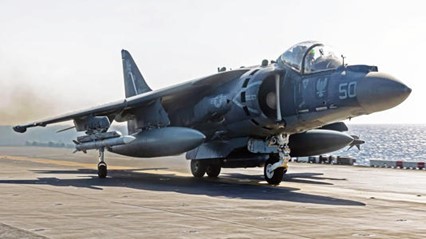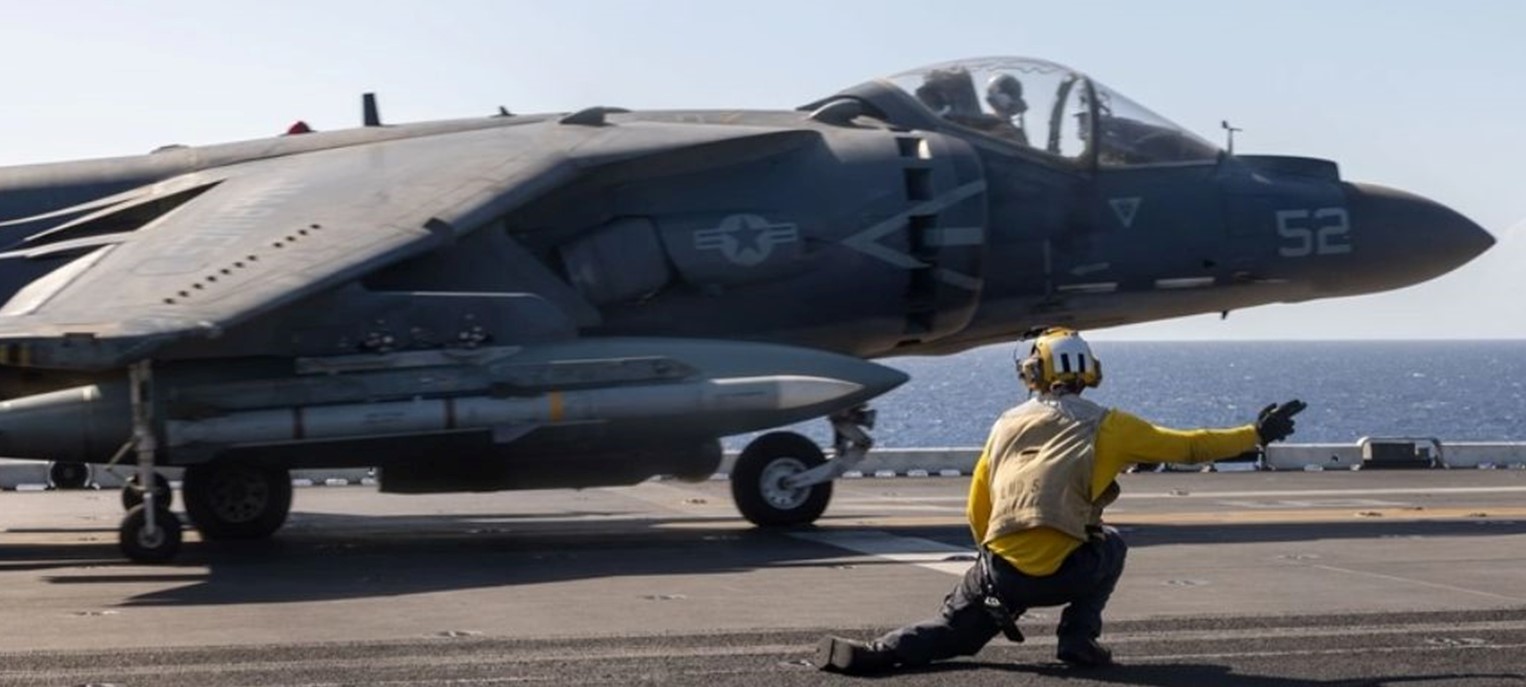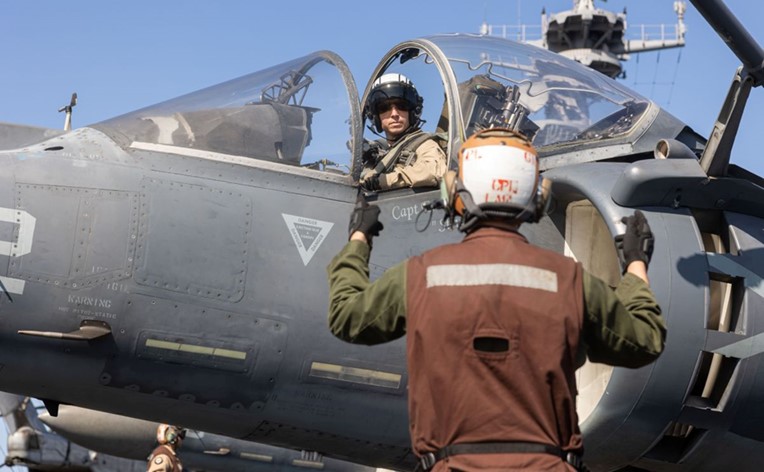By: Warren Gray
Copyright © 2024
“I never imagined I was going to be doing this when we launched…
The Houthis were launching a lot of suicide-attack drones…They
are shooting at us all the time…We took a Harrier jet, and modified
it for air defense. We loaded it up with missiles, and that way were
able to respond to their drone attacks.”
— Captain Earl Ehrhart V, USMC
It was one of the coolest commercials I’ve ever seen, dating back to 1984, while I was stationed in West Germany with the U.S. Air Force. A young man, about college age, is walking along a country road with trees on both sides, and a sleek jet fighter passes low overhead, slowing down. As the man approaches a clearing up ahead, the jet lands vertically on the grassy field, like a helicopter, and he walks up beside it. The canopy slides back, but there’s no pilot inside, and a deep voice announces, “It’s called the Harrier, and the Marines are looking for a few good men to fly it.”
The McDonnell-Douglas (now Boeing) AV-8B Harrier II is a single-engine fighter-attack aircraft designed in England for the Royal Air Force and Royal Navy (Sea Harriers proved particularly deadly in the Falklands War of 1982, scoring 20 aerial kills, mostly with AIM-9L Super Sidewinder missiles), and produced for the U.S. Marine Corps from 1983 to 2003, with the very rare distinction of having four swiveling exhaust nozzles, and the ability to take off and land either conventionally, like most aircraft, or vertically, from very tight spaces, like a forest, or a naval vessel at sea.
The current version in active service with the Marines is the AV-8B Harrier II Plus, of which 72 were constructed by December 2003, when production ended. It’s normally a ground-attack aircraft, still in service with the Marine Corps until 2027, and also serving with the Italian Navy and the Spanish Navy. The Harrier II Plus features an APG-65(V3) pulse-Doppler radar, taken from retired, F/A-18A/B Hornet jet fighters in 1992, and the ability to launch AIM-120C-7 Slammer active-radar-guided missiles.
Marine Corps Captain Earl Ehrhart V was deployed aboard the USS Bataan (LHD-5) amphibious assault ship of the U.S. Navy, basically a small aircraft carrier, normally carrying six AV-8B Harrier II Plus aircraft, four AH-1Z Viper attack helicopters, 12 MV-22B Osprey tilt-rotor, transport aircraft, and eight CH-53E and UH-1Y Venom transport helicopters. In early October 2023, the vessel and its Bataan Amphibious Ready Group (ARG) of other ships in the Red Sea were due to rotate back home to North Carolina.
But on October 7, 2023, Hamas terrorists on the Gaza Strip adjoining Israel attacked the Jewish nation, murdering at least 1,200 innocent people. The Bataan ARG was ordered to the eastern Mediterranean Sea to monitor the hostile activity. But just 12 days later, Iranian-backed Houthi guerillas in Yemen began launching kamikaze attack drones against more than two dozen U.S. naval vessels and commercial shipping in the volatile Middle East region.
So, the Bataan ARG and its 26th Marine Expeditionary Unit (Special Operations Capable) redeployed to the Red Sea again, closer to Yemen, to confront this terrorist threat. In January 2024, the U.S. and U.K. ordered airstrikes against Houthi positions in retaliation.
Captain Ehrhart is assigned to Marine Attack Squadron 231 (VMA-231), the “Ace of Spades,” flying a half-dozen AV-8B Harrier II Plus “jump-jets,” with his designated aircraft bearing the number “52” in light gray on each side of the nose section.
The Harrier is normally employed in the ground-attack role, and may be armed with a wide variety of munitions on six wing hardpoints, including 370-gallon, external fuel tanks, an AAQ-28V Litening targeting pod (usually mounted on the aircraft’s belly), laser-guided and GPS-guided bombs, cluster bombs, AGM-65E/F Maverick missiles, unguided rockets, or AGR-20B laser-guided missles. But it may also carry up to four AIM-120C-7 Slammer radar-guided missiles, or AIM-9M Super Sidewinder heat-seeking missiles for self-defense in aerial combat.
In addition, there is a General Dynamics GAU-12/U “Equalizer” five-barrel Gatling gun in 25x137mm below the fuselage in the left belly pod, firing at a rate of 60 to 70 rounds per second, and offset on the right side by another pod holding 300 rounds of 25mm ammunition. This gun system is removable, however, and Harriers often fly without it.

AV-8B Harrier II Plus on USS Bataan, armed with AIM-120C-7 and AIM-9M missiles. Photo credit: U.S. Marine Corps
During this Red Sea crisis of January 2024, Ehrhart’s jet and other Harriers were fully loaded with AIM-9M and AIM-120C-7 air-to-air missiles, to counter the incoming swarms of Houthi suicide-attack drones. During these intense operations, the U.S. Navy and Marine Corps managed to shoot down 14 anti-ship, ballistic missiles (for the first time in actual combat history), seven inbound, cruise missiles, and more than 70 Houthi armed attack drones.
Captain Ehrhart’s own AV-8B aircraft, #52, was photographed at sea on December 26, 2023, just before this crisis began, clearly armed with an AIM-120C-7 Slammer air-to-air missile on the right, outboard wing station.

Captain Ehrhart taking off in #52 from the USS Bataan on December 26, 2023. Photo credit: U.S. Marine Corps
Ehrhart was personally responsible for shooting down seven armed Houthi drones, 10-percent of the entire task force total, a very difficult and dangerous task, because the drones often explode in mid-air, blasting debris and shrapnel in all directions.
According to the American Fighter Aces Association (AFAA), any U.S. military pilot who shoots down five or more confirmed enemy aircraft of any type, in aerial combat, is considered to be an “ace.” The United States had only five aces (two Navy, and three Air Force) during the Vietnam War, and none since then, so Captain Earl Ehrhart V is apparently the first American “ace” pilot in the past 52 years!
Drone warfare has rapidly become the wave of the future in modern combat, especially in the current Russo-Ukraine war, with very tiny, stealthy, inexpensive, unmanned drones able to precisely locate and attack enemy positions without endangering a multi-million-dollar aircraft, or the lives of its pilots. It makes perfect sense from a military perspective.
The embattled nation of Ukraine already has at least one drone ace, Major Vadym Voroshylov, the fabled “Ghost of Vinnytsia,” a MiG-29S Fulcrum-C jet fighter pilot with five confirmed drone kills to his credit by late December 2022. And much more recently, Ukrainian paratrooper Sergeant Dmytro A. (last name withheld) shot down five Russian drones from the ground in late December 2023, with his ordinary, AKS-74M assault carbine. So, drone warfare is here to stay, and it’s a very clear and present danger, which must be countered efficiently by U.S. and allied forces.
Captain Ehrhart stated quite humbly that, “Every time I take to the skies, I know that my actions could mean the difference between peace and chaos. It’s a heavy responsibility, but it’s one that I shoulder with pride.”
* * *
Warren Gray is a retired U.S. Air Force intelligence officer with experience in joint special operations and counterterrorism. He served with two U.S. fighter squadrons in Europe, and one in the Middle East, earned Air Force and Navy parachutist wings, four college degrees, including a Master of Aeronautical Science degree, and was a distinguished graduate of the Air Force Intelligence Operations Specialist Course, and the USAF Combat Targeting School. He is currently a published author and historian.

